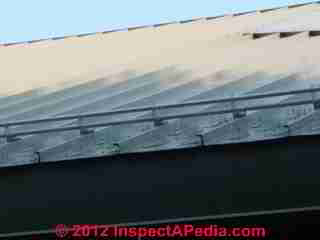Metal Roofing Snow Guard Installation
Snow Guard Installation Services. Snow or ice accumulation on your roof during the winter can be hazardous and destructive. But with a new snow guard installation on your home’s roof, you can avoid a dangerous situation. Snow guards protect the quality and longevity of your roof by preventing snow from sliding off. The roof sheds snow just fine except above the chimney where it slides into the chimney, forms 1-2 feet of solid blue ice with about 3-4 feet of snow on top. This weight presses against the metal chimney threatening to crush it. I do not believe a snow fence could handle such a load but, I am not an expert. Some local roofers want to tear off.

Metal roofs have many advantages, among them long life and near imperviousness to damage by hail and wind. They are also non-flammable—an increasingly important virtue in areas where wildfires are a danger. Metal roofs can greatly reduce the likelihood of a home catching fire from falling embers.
There is one common problem with metal roofing systems, though. They are prone to snow build-up that can suddenly break loose in a massive slide that covers anything below the roofline—including patio furniture, air conditioner compressors, and other valuable items. Unlike shingle roofs, metal roofs have smooth surfaces that do not provide any resistance to keep snow from sliding off. In addition, metal roof systems absorb heat from the sun, warming the surface in a way that lubricates the layer of snow and causes it to slide off easier and faster. The danger here is not only possible property damage but physical injury if a person happens to be standing below the edge of the roof when a huge mass of snow breaks loose. Many tons of snow can bury anything in its way, and can even smother people or pets.
Adapting the Standard Solution

In regions of heavy snowfall, the traditional method for preventing roof avalanches is to either remove heavy loads of snow with a snow rake—a very laborious process—or to install snow guards (also called snow stops) that extend up from the roof surface to hold snow in place and keeping it from sliding off.
But there are particular complications when it comes to installing snow guards on a metal roofing system. Most metal roof systems are installed in a way that allows the metal panels to float freely above the underlying roof deck or framing. This makes it possible for the metal panels to expand and contract at a different rate than the structure beneath them—a necessary part of the engineering since metal expands and contracts quite a lot as temperatures change. If you attach any type of snow guard by driving fasteners through the metal and into the roof deck, it will compromise the metal panels, eliminating their ability to float and creating an opportunity for leaks to develop.
Fortunately, there is a special type of non-penetrating, adhesive snow stop made for metal roofs. This system uses polycarbonate cleats that are applied to the metal panels using peel-and-stick or caulk-gun adhesives rather than by driving metal fasteners. The cleats prevent huge masses of snow from breaking free; instead, they break up the snow into smaller, harmless sections. Properly applied, they have proven to be just as durable and effective as nail-on snow guard cleats.
Installing Adhesive Snow Guards
Metal Roof Snow Guard Spacing
Follow the manufacturers recommendations for the number and spacing of snow guards. The recommended pattern and number of snow guard cleats is based on several factors, including the slope of the roof, the rafter length, and the anticipated snowfall in your region.
The following is a recommended method for installing adhesive snow guards onto the surface of a metal roof system:
- Read the manufacturer’s installation instructions for the recommended temperature range for installation. Many manufacturers will give a minimum temperature which must be maintained for a minimum number of days to ensure good bonding to the metal.
- Clean the surface of the metal roof panels with soap and water. It is also possible to use rubbing alcohol to clean the surface. Make sure that the surface of the metal panel is dry and clean before proceeding with the installation. Any contaminants will compromise the adhesion of the snow guards.
- Apply a full bead of adhesive to the underside of the snow guard. Pay particular attention to the manufacturer’s instructions for application of the adhesive, and for spacing of the snow guard cleats on the roof.
- As you press the snow guard to the surface of the metal roof panel, make sure that there is no trapped air beneath it.
- Neatly tool the sealant around the top, leading edge of each snow guard to ensure that there are no gaps or voids in the sealant. Gaps may allow water to enter under the snow stop and become trapped there—this will gradually compromise the adhesion.